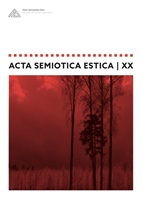Visuaalkunsti ikoonilistest väljendusvahenditest Vassili Kandinsky kompositsiooniteooriast lähtudes
Iconic means of expression in visual art based on Wassili Kandinsky`s theory of composition
Author(s): Krista SimsonSubject(s): Semiotics / Semiology, Visual Arts, Semantics, Sociology of Art, History of Art
Published by: Eesti Semiootika Selts
Keywords: visual semiotics; visual arts; meaning-making; Kandinsky; composition theory; iconic means of expression;
Summary/Abstract: The author of this article aims to show that the principles of composition and semiotic analysis of a work of visual art are compatible if the structure of the work’s elements and the relationships between them, i.e., composition, are taken as a basis. The article provides an overview of the means of creating meaning in composition, notably based on Wassily Kandinsky’s composition theory. The principles that Kandinsky points to in his theory are used to create the meaning of a work of visual art to this day: iconic means of expression constructed from stimuli affecting perceptions are the primary material of visual rhetoric. Therefore, the process of creating meaning cannot be ignored in the semiotic analysis of art, whereby composing iconic means of expression – form, color, diagrammatic, and topographical relations – creates connections that are both formal and semantic, whether it is a traditional pictorial composition, or frames of a video, an animation or a film.
Journal: Acta Semiotica Estica
- Issue Year: 2023
- Issue No: 20
- Page Range: 89-114
- Page Count: 26
- Language: Estonian

